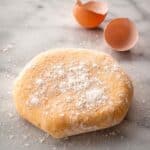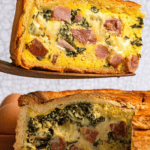Pizza Rustica (Easter Pie Recipe)
This savory Pizza Rustica, also called Italian Easter Pie, combines a buttery pie crust filled with a cheesy filling of egg custard studded with salty Italian meats. It's a traditional recipe with an impressive presentation that's perfect for Easter Sunday or any special occasion!
This post may contain affiliate links.
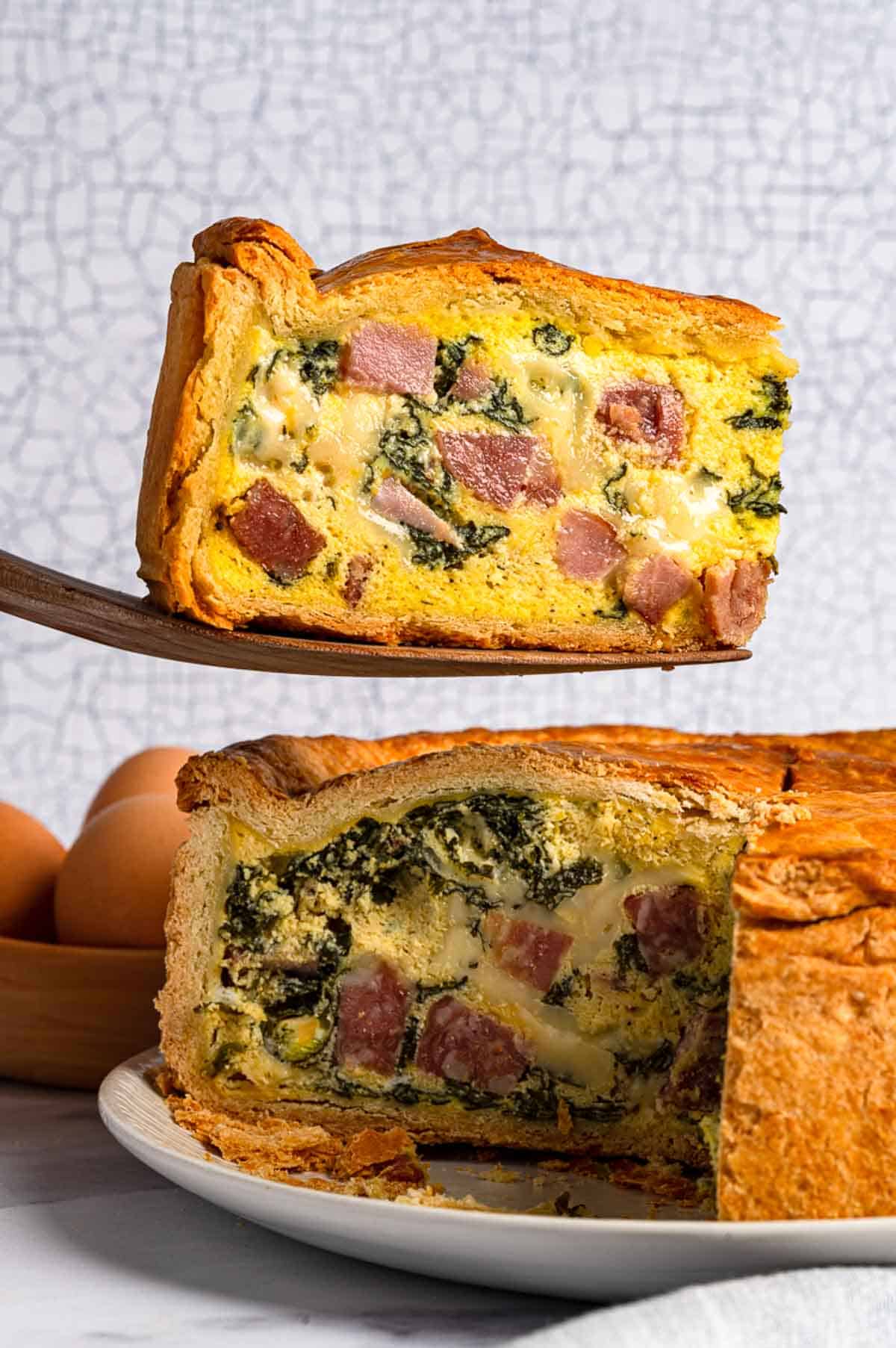
What is Pizza Rustica?
Pizza Rustica, also known as Italian Easter Pie, Pizza Chiena, Pizza Ripiena (filled pizza), or Pizza Gaina, is a traditional savory pie from Southern Italy. Despite having "pizza" in its name, it's quite different from what most people associate with the word "pizza," like this Pizza Margherita.
Instead, it features a buttery pastry dough rather than pizza dough, filled with a rich mixture of cured meats, cheeses, and eggs, making it closer to a savory pie or quiche.
This hearty dish is traditionally enjoyed on Easter Sunday, marking the end of Lent and celebrating the arrival of spring. Throughout southern Italy, you'll find lots of regional variations with different fillings, but it can be adapted to use whatever meats and cheeses you prefer.
This rustic pie is a labor of love and ideal to be made in advance. Prepare it on Good Friday, serve it for Easter Dinner and then enjoy the leftovers on Easter Monday!
Want more Italian Easter recipes? Try my creamy Italian Ricotta Pie, these vibrant Fava Bean Crostini, or this seasonal Spring Vegetable Risotto.
Why This Recipe Works
- Adaptable with different Italian meats and cheeses.
- Perfect for any meal— Enjoy it warm, at room temperature, or cold.
- A great make-ahead recipe that tastes even better the next day!

Easter Pie Ingredient Notes
Italian Cured Meats - The salami and sopressata can be replaced with any other types of Italian cured meats that sound good to you. There are some with a lot of pepper, some with red wine. The varieties are endless! If prosciutto cotto is difficult to find, substitute high-quality ham that doesn't have strong added flavors.
Cheeses - I use a combination of fresh mozzarella, creamy ricotta (try my homemade ricotta recipe!) and parmesan cheese for the best mix of textures and flavor. Basket cheese is more commonly used in place of the ricotta, but it can be tricky to find. For a slightly sharper taste, replace the parmesan with pecorino Romano cheese or other pecorino cheeses. Check out my guide to Italian cheeses for more ideas!
Spinach - This is optional in the recipe but adds nice color and nutrition. You can substitute frozen spinach that's been defrosted and thoroughly squeezed of its liquid - about 5 ounces of frozen spinach equals the 8 ounces of fresh called for in this recipe.
*Find the full ingredient list in the recipe card below!
Helpful Equipment
- Mixing bowls
- Rolling pin
- 9” Spring form pan
- Pastry brush
- Thermometer
- Microplane grater or fine grater
How to make Pizza Rustica (Italian Easter Pie)

For the Crust
- In a large bowl, combine flour and salt, whisking together the dry ingredients.
- Sprinkle in the cubes of cold butter and use a pastry cutter or your fingers to work it in until coarse crumbs and pea-sized pieces of butter form.
- Add the beaten eggs and combine, then add 1 tablespoon of ice water at a time until you get a ball of dough.
- Cut ⅓ of the dough from the ball, flatten both pieces into discs, wrap with plastic wrap and refrigerate for 1 hour.
Pro Tip: When making the dough, add just one tablespoon of ice water at a time. The dough takes time to absorb water - if you add too much too quickly, you'll end up with overly wet dough. If this happens, just add a tablespoon of flour to balance out the dough. You can also prepare the dough in a food processor.

For the Filling
- In a pot of boiling water with a pinch of salt and a squeeze of lemon juice, add the spinach and blanch for 30 seconds. Remove with a slotted spoon, transfer to a bowl, and run under cold water.
- Squeeze out all water and place into a large mixing bowl.
- To the same mixing bowl, add the filling ingredients: large eggs, salami, sopressata, prosciutto cotto, fresh mozzarella, ricotta cheese, parmesan cheese, salt, and black pepper to create the ricotta egg mixture.

Assembly
- Preheat the oven to 375°F. Spray your springform pan with olive oil cooking spray and set aside.
- On a lightly floured, clean surface, roll out the larger portion of the dough into a 14–16" round, about ⅛" thick. Then, roll out the smaller portion to approximately 10–12" wide and ⅛" thick for the top crust.
- Roll out the smaller remaining dough to roughly 10-12" wide and ⅛" thick for the top crust.
- Transfer the larger piece of dough into the springform pan, making sure the dough goes up the sides of the pan and hangs over the edges.
- Pour the egg ricotta mixture into the bottom crust, then place the top dough layer on, folding the edge of the dough from the bottom crust over the top crust, crimping the edges of the doughs together and cutting off any excess dough with a sharp knife. Make sure to cut slits on the top of the pie to allow steam to escape.
Pro Tip: It's crucial to fold the bottom crust over the top crust and pinch them together to form a complete seal. Without this step, your filling might leak out during baking. When cutting slits in the top of the pie for ventilation, make sure the cuts go all the way through.
- Make an egg wash by combining 1 egg with 1 tablespoon of water and brush the top of the pie. If you're out of eggs, 2 tablespoons of milk works as an alternative.
- Place the pie on a baking sheet with parchment paper to catch any drips and bake in the bottom of the oven for 1 hour or until golden brown and the internal temperature reaches 165°F. Remove from the oven and let cool on a wire rack before removing the springform pan.
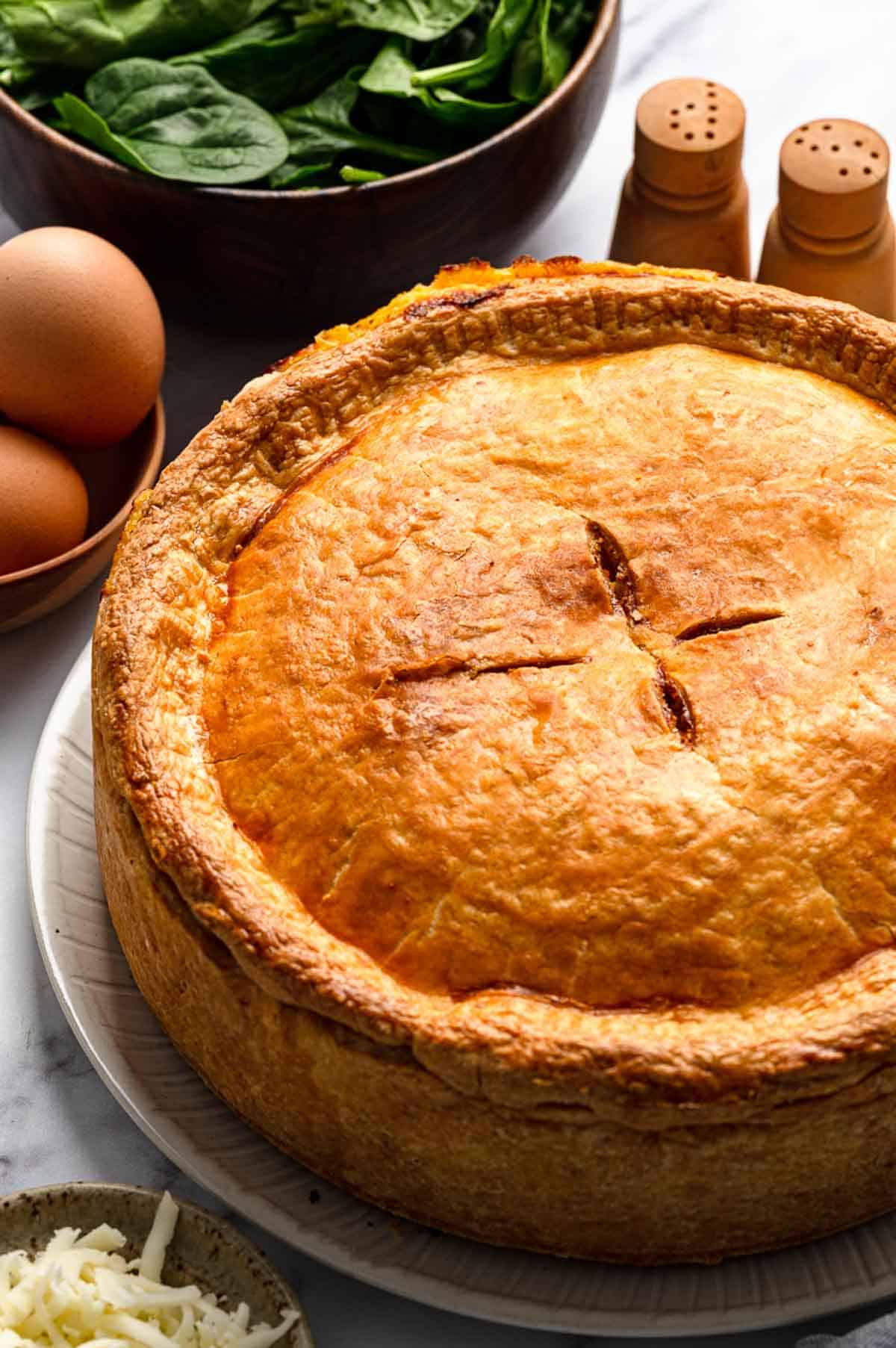
Easter Pie Recipe Tips
- Letting the pastry dough rest is essential. Without proper resting time, the dough may be too crumbly to place on your work surface.
- The edges of your pie crust might brown faster than the center. If this happens, cover with aluminum foil to protect the edges.
- Allow the pie to cool before removing it from the pan. As it firms up, it becomes easier to slice with a sharp knife.
Variations
- Try different Italian deli meats like mortadella, capocollo, or sweet Italian sausage for unique flavor combinations.
- Experiment with a variety of cheeses like provolone, fontina, or the more traditional basket cheese.
- Add some fresh herbs to the filling, like parsley or basil, for extra flavor.
- For a traditional southern Italy approach, add whole hard-boiled eggs within the filling.
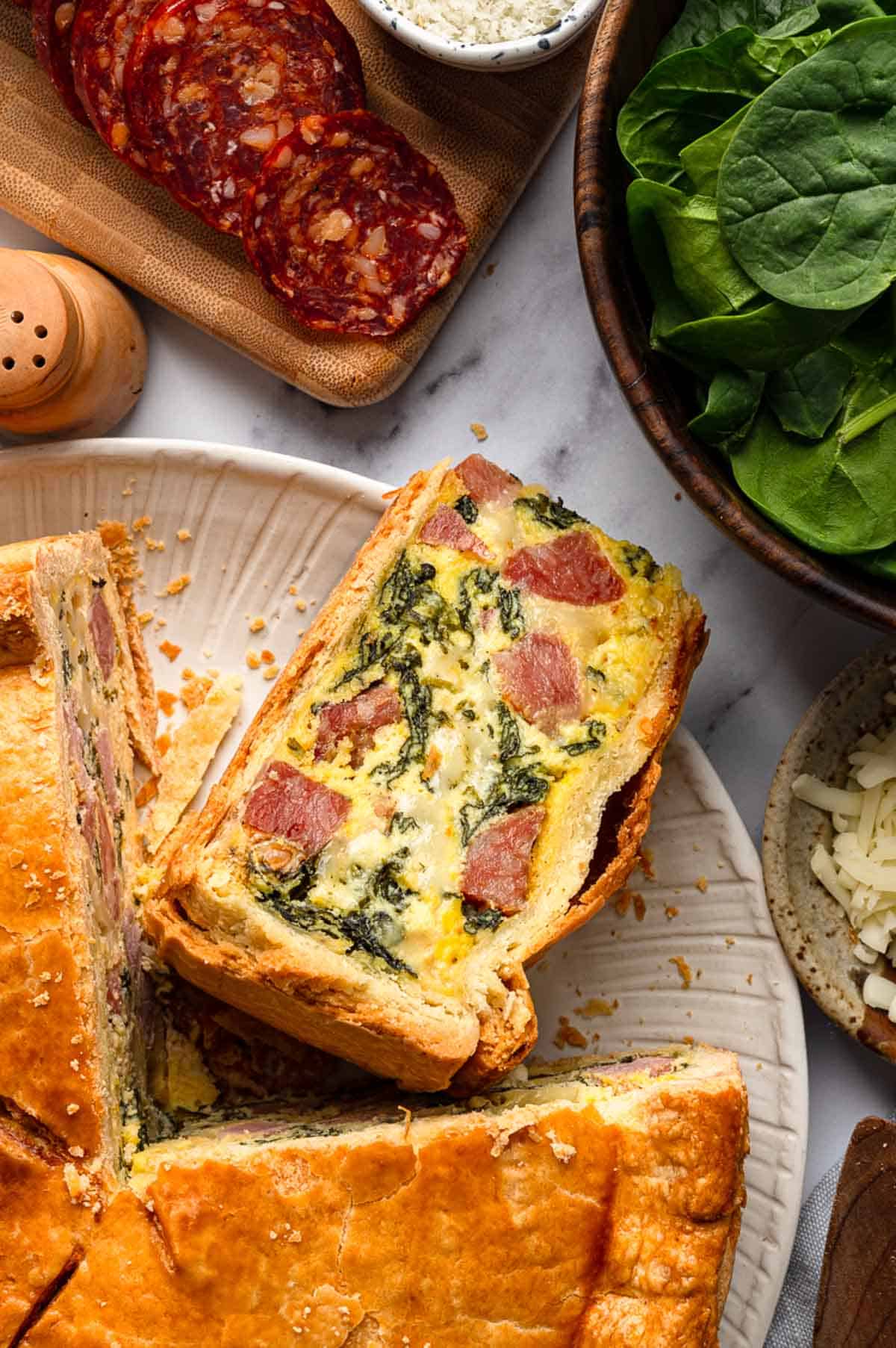
Serving Suggestions
Serve as part of a traditional Italian Easter feast with my elegant Beef Carpaccio as a starter. For an entree, pair it with a succulent Whole Roasted Beef Tenderloin or an aromatic Dijon Herb Crusted Rack of Lamb.
Balance the richness with seasonal vegetables like my crisp Shaved Asparagus Salad or vibrant Peas with Prosciutto and Ricotta.
How to Store this Pizza Rustica Recipe
Pizza Rustica can be refrigerated for 3-5 days wrapped tightly in plastic wrap. The flavors and textures improve after a day, making it an excellent make-ahead dish.
To reheat, warm it in a 325°F oven for about 15-20 minutes.

Easter Pie / Pizza Rustica FAQs
Pizza Rustica can be enjoyed either warm, at room temperature or even cold. Traditionally, it's often served at room temperature, which allows the flavors to fully develop.
Yes, it can be frozen, though it will change the texture somewhat. You can freeze it after it has completely cooled either whole or in individual slices wrapped tightly in plastic wrap or aluminum foil. It will keep for up to 3 months frozen. Just be aware that the buttery crust may not be quite as flaky and the filling might be slightly less creamy after freezing and thawing.
To reheat Pizza Rustica, place it in a preheated 325°F oven for 15-20 minutes (if frozen, remember to thaw first). Covering with aluminum foil prevents the top of the pie from over-browning. Avoid microwaving, as this can make the pastry crust soggy.
Did you LOVE this recipe? Please leave a star ⭐️ rating and comment and tag your creations @ColeyCooks on Instagram!
Want to Save This Recipe?
Enter your email & I'll send it to your inbox.
By submitting this form, you consent to receive emails from Coley Cooks.
Easter Pie (Pizza Rustica Recipe)
Ingredients
For the Crust
- 3 ½ cups all purpose flour
- 1 teaspoon Kosher salt
- 2 sticks unsalted butter cold, cut into small cubes
- 3 eggs + 1 set aside for an egg wash
- 2 to 4 tablespoons ice water
For the Filling
- 10 ounces fresh spinach 1 (10 ounce) package
- 8 eggs beaten
- 5 ounces salami cut into ½ inch cubes
- 5 ounces sopressata cut into ½ inch cubes
- 5 ounces prosciutto cotto or good quality ham cut into ½ inch cubes
- 2 cups mozzarella cheese (8 ounces), diced into small cubes
- 15 ounces ricotta cheese 1 (15 ounce) container
- 1 cup parmesan cheese freshly grated
- 1 teaspoon salt
- ½ teaspoon black pepper freshly ground
Instructions
For the Crust
- In a large bowl, whisk together the flour and salt.
- Sprinkle in the cubes of butter and knead with your hands and fingers until pea sized pieces form.
- Add the eggs and combine, then 1 tablespoon of cold water at a time until the dough comes together. Shape into a ball.
- Cut ⅓ of the dough from the ball, flatten both pieces into discs, wrap with plastic wrap and place in the fridge for 1 hour.
For the Filling
- In a pot of boiling water with a pinch of salt, add the spinach and blanch for 30 seconds. Remove with a slotted spoon, transfer to a bowl, and run under cold water.
- Squeeze out all of the water and place into a large mixing bowl.
- To the same mixing bowl, add the eggs, salami, sopressata, prosciutto cotto (or ham), mozzarella, ricotta, parmesan cheese, salt, and pepper.
Assembly
- Preheat the oven to 375°F degrees. Spray your 9” spring form pan with cooking spray and set aside.
- While the oven is preheating, roll out the larger piece of dough on a flat surface that is approximately 14-16” round and about ⅛” thick.
- Next, roll out the smaller piece of dough to roughly 10-12” wide and ⅛” thick.
- Transfer the larger piece of dough into the spring form pan, making sure the dough goes up the sides of the pan and hangs over the edges.
- Pour the filling into the crust, then place the smaller crust on top, folding the bottom crust over the top crust, crimping the edges together and cutting off any excess dough with a knife or scissors. Make sure to cut slits on the top of the crust to allow steam to escape.
- Make an egg wash by combining 1 egg with 1 tablespoon of water and brush the crust with the egg wash.
- Bake in the oven for 1 hour or until the internal temperature reaches 165°F degrees (it will continue to rise in temp).
- Remove from the oven and let cool slightly on a wire rack before removing the spring form pan. Slice and enjoy!
Notes
- When you are making the dough, make sure to add one tablespoon of ice water, then combine, before adding another one if necessary. It can take a little while for the dough to absorb the water so if you add too much when you think it’s dry, it will become too wet! If this ends up happening, just add a tablespoon of flour to balance out the dough.
- It’s really important to fold the bottom crust over the top crust and pinch together so it forms a complete seal. If you don’t do this, your pie crust will have a possible separation and the eggs could leak out.
- When you slit the pie on top for ventilation, make sure the cut goes all the way through the dough and wiggle the knife a bit as you do this to open more than normal. As it bakes, the dough will expand and close the hole which prevents steam from escaping.
- The edges of your pie crust might start browning faster than the middle. If this is the case, you can either place an adjustable pie crust shield around the edges or create a shield using aluminum foil.
- Don’t forget to let the pie cool slightly before removing it from the springform pan. As it cools, it will firm up and you will have an easier time cutting it. If you cut it when it’s still very hot, the crust and the insides could crumble all over.
- Letting the dough rest is very important for moisture absorption. If you don’t allow the dough to rest, it could be too crumbly and might not hold up to rolling it out.

